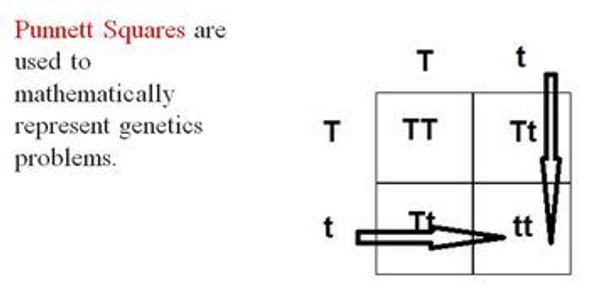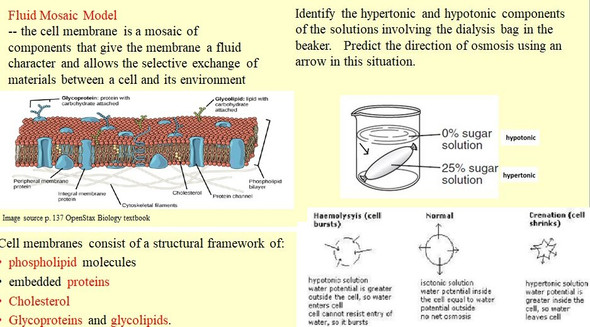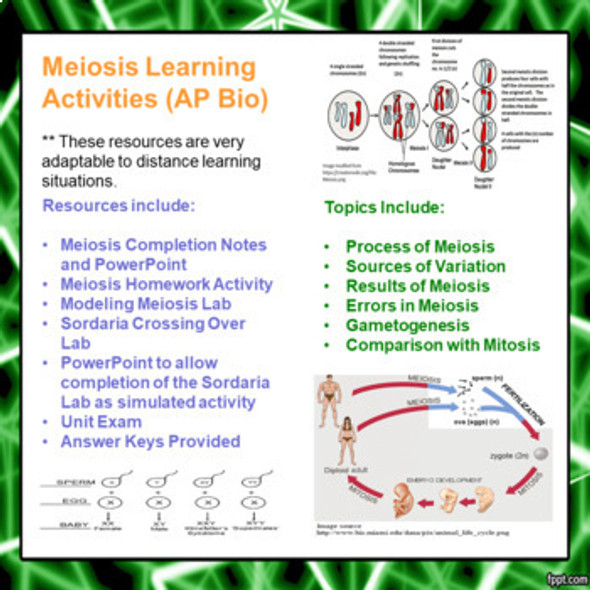Mendelian/Classical Genetics Learning Activities for AP Biology (Distance Learning)
- Bulk Pricing:
- Buy in bulk and save
- Contributor:
- Monday's Rescue
- Grade Level:
- 9-12
- Product Type:
- Learning Package (Notes, PowerPoint, Lab, Homework)
- File Type:
- doc, pdf, ppt
- Pages:
- 44
- Answer Key:
- Yes
Description
This zip file contains many different activities (44 pages of student handouts and 2 PowerPoints to accompany the note handouts with a total of (83 slides) which can be used to compose a unit for AP Biology or advanced Biology students on Mendelian Genetics and Advanced Genetics Crosses. Mendel's Laws as well as the associated terminology and crosses introduce the unit. Many other concepts are addressed including but not limited to; probability, incomplete dominance, codominance, multiple alleles, blood group inheritance, lethal alleles, sex-linked crosses and the some influences of environment on phenotype as specified in the AP Biology curriculum framework. The mathematics of chi square is included on the corn genetics activity. This packet of materials contains 5 worksheets with PowerPoint keys, several practice problem packets with keys and a lab activities. A comprehensive examination and key for the unit is also included.
This lesson packet contains a listing of the learning goals, common core learning standards, NGSS learning standards and the AP Biology performance indicators addressed in these materials. These are included in the packet and at the end of the description of this lesson. The learning guides/assignments contain links to online resources to support student learning. Answer keys are included for most items with the exception of one lab activity and portions of lab activities where student answers may vary.
Most documents are included in both word doc or docx as well as pdf format to allow editing for specific teacher needs. These learning materials are well suited for a distance learning situation.
The specific contents of the learning package includes the following items (the page count for these items are actual student handouts as answer key page counts are not included):
-- Classical Genetics and Environmental Influences Objectives (3 pages) in word and pdf format
-- Basic Mendelian Genetics Completion Cloze notes with learning goals (9 pages) in word and pdf format
-- PowerPoint to accompany the Basic Mendelian Genetics Completion notes (57 slides)
-- Beyond Mendelian Genetics Completion Cloze Notes with learning goals (15 pages) in word and pdf format
-- PowerPoint to accompany the Beyond Mendelian Genetics Completion notes (56 slides)
-- Mendelian Genetics Review quiz with answers (23 questions/4 pages) (pdf format only)
-- Advanced Genetics Practice Exam with answers (55 questions/5 pages) (pdf format only)
-- Genetics Worksheet One (Law of Dominance) (1 page/8 questions) in word and pdf format
-- Genetics Worksheet One answer key in PowerPoint (18 slides)
-- Genetics Worksheet Two (Mendelian crosses) (12 questions/1 page) in word and pdf format
-- Genetics Worksheet Two answer key in PowerPoint (20 slides)
-- Genetics Worksheet Three (codominance and incomplete dominance) (5 questions/1 page) in word and pdf format
-- Genetics Worksheet Three answer key in PowerPoint (5 slides)
-- Genetics Worksheet Four (Blood and Sex-Linked crosses) (7 problems/1 page) in word and pdf format
-- Genetics Worksheet Four answer key in PowerPoint (22 slides)
-- Corn Genetics Lab (requires purchased corn sample results from a dihybrid cross) (4 pages) in word and pdf format (key included)
-- Classical Genetics and Environmental Influences Exam and Key (40 multiple choice questions/7 pages) in word and pdf
-- Helpful Animations and Video List (1 page) in word and pdf with interactive links
-- Classical Genetics and Environmental Influences Objectives (3 pages) in word and pdf format
Classical Genetics and Environmental Influences Objectives ETS
Enduring Understandings
IST-1 Heritable information provides for continuity of life.
SYI-3 Naturally occurring diversity among and between components within biological systems affects interactions with the environment.
Learning Objectives
IST-1.I Explain the inheritance of genes and traits as described by Mendel’s laws.
IST-1.J Explain deviations from Mendel’s model of the inheritance of traits.
IST-1.K Describe the structures involved in passing hereditary information from one generation to the next.
IST-1.O Describe how the phenotype of an organism is determined by its genotype.
SYI-3.B Explain how the same genotype can result in multiple phenotypes under different environmental conditions.
SYI-3.C Explain how chromosomal inheritance generates genetic variation in sexual reproduction.
Classical Genetics and Environmental Influences Learning Goals
Upon the completion of this unit the student will be able to:
1. list several features of Mendel's methods that contributed to his success.
2. list and explain Mendel's laws of heredity
3. use a Punnett square to predict the results of a monohybrid cross and state the phenotypic and genotypic ratios of the F2 generation.
4. distinguish between genotype and phenotype; heterozygous and homozygous; dominant and recessive.
5. explain how a testcross can be used to determine if a dominant phenotype is homozygous or heterozygous.
6. state Mendel's law of independent assortment.
7. use a Punnett square to predict the results of a dihybrid cross and state the phenotypic and genotypic ratios of the F2 generation.
8. using the laws of probability, predict the results of dihybrid and trihybrid crosses.
9. state several; examples of incomplete dominance and explain this it is not evidence for the blending theory of inheritance.
10. explain how the phenotypic expression of the heterozygote is affected by complete dominance, incomplete dominance and codominance.
11. describe the inheritance of the ABO blood system and explain why the IA and IB alleles are said to be codominant.
12. describe a simple model for polygenic inheritance, and explain why most polygenic characters are described in quantitative terms.
13. describe how environmental conditions can influence the phenotypic expression of a character.
14. given a simple family pedigree, deduce the genotypes for some of the family members.
15. describe the inheritance of sickle cell disease.
16. explain how a lethal recessive gene can be maintained in a population.
17. explain why consanguinity increases the probability of homozygosity in offspring.
18. explain why lethal dominant genes are much more rare than lethal recessive genes.
19. give an example of a late-acting lethal dominant in humans and explain how it can escape elimination.
20. describe sex determination in humans.
21. describe the inheritance of a sex-linked gene such as color-blindness or hemophilia
22. explain why a recessive sex-linked gene is always expressed in human males.
23. explain the difference between deletion, translocation, and inversion mutations.
24. explain why cytoplasmic genes are not inherited in a Mendelian fashion.
25. list and discuss some examples of environmental influences on phenotype.
NGSS Standards
Students who demonstrate understanding can:
HS-LS3-1. Ask questions to clarify relationships about the role of DNA and chromosomes in coding the instructions for characteristic traits passed from parents to offspring.
HS-LS3-2. Make and defend a claim based on evidence that inheritable genetic variations may result from: (1) new genetic combinations through meiosis, (2) viable errors occurring during replication, and/or (3) mutations caused by environmental factors.
Common Core State Standards Connections:
ELA/Literacy
RST.11-12.1 Cite specific textual evidence to support analysis of science and technical texts, attending to important distinctions the author makes and to any gaps or inconsistencies in the account.
RST.11-12.9 Synthesize information from a range of sources (e.g., texts, experiments, simulations) into a coherent understanding of a process, phenomenon, or concept, resolving conflicting information when possible.
WHST.9-12.1 Write arguments focused on discipline-specific content.
Mathematics
MP.2 Reason abstractly and quantitatively.
Terms of Use
Purchase of the product is for classroom use by the purchaser only. It is a violation for individuals, schools, and districts to redistribute, sell, or post this item on the Internet or to other individuals.
This work is licensed under a Creative Commons Attribution-NonCommercial-ShareAlike 4.0 International License.
This learning package bundle is part of the AP Biology Complete Course. The complete course contains 22 learning package bundles in addition to this one. Save nearly 60% over the cost of buying 23 individual unit learning bundles with your purchase of the complete course.
Check out Monday's Rescue for more great resources!














